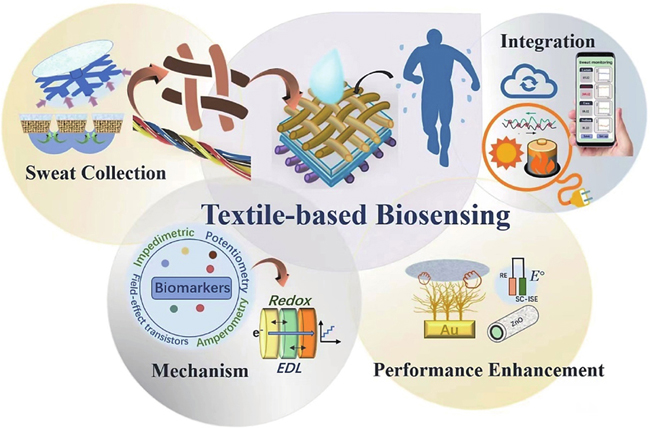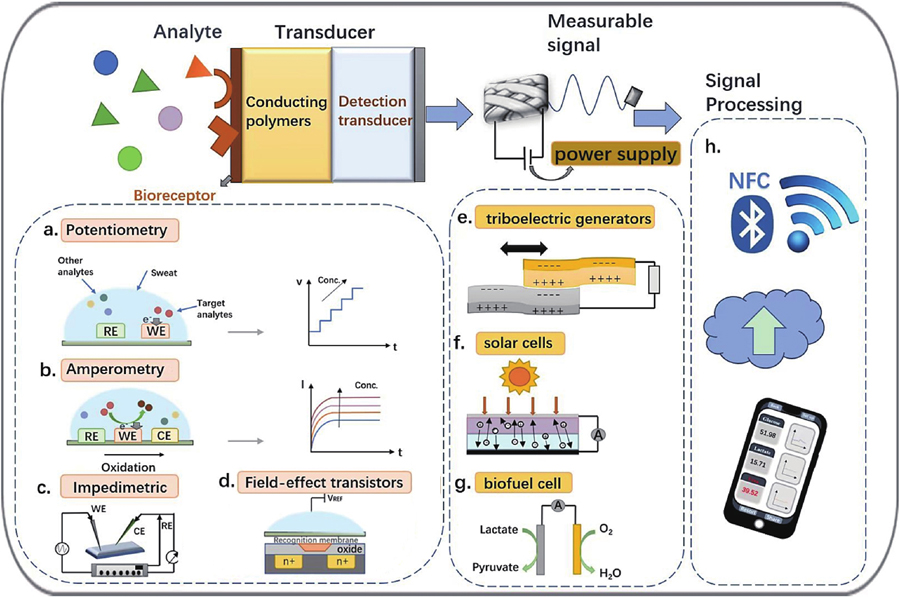Yuqing Shi, Ziyu Zhang, Qiyao Huang, Yuanjing Lin, Zijian Zheng. Wearable sweat biosensors on textiles for health monitoring[J]. Journal of Semiconductors, 2023, 44(2): 021601
Search by keywords or author
- Journal of Semiconductors
- Vol. 44, Issue 2, 021601 (2023)

Fig. 1. (Color online) Textile-based sweat biosensors show promising applications in non-invasive and wearable health monitoring. Research advances in understanding the biosensing mechanism, efficient sweat collection strategies, high-performance biosensor fabrication, and system integration are critical to achieving desired textile-based sensing platforms.

Fig. 2. (Color online) Schematic diagram of electrochemical biosensor system. A typical electrochemical biosensor includes identification module, sensor module, signal processing, transmission module, and power supply module.
Fig. 3. (Color online) Response mechanisms of ion-selective membrane. (a) The capacitive redox mechanism (with PEDOT as an example). (b) The capacitance mechanism of EDL (with carbon as an example).
Fig. 4. (Color online) Example for 1D fiber-based sensor and 2D cloth-based sensor. (a) The morphology and mechanism of lactate working electrode. (b) Schematic diagram and physical diagram of the lactic acid sensor,
Fig. 5. (Color online) Sampling in wearable sweat sensors. (a) Sweat rate of various parts of the human body under different exercise intensities[70]. (b) Efficient sweat collection strategy on textiles with fast water absorption properties and laser-engraved dendritic bifurcated channels[67]. (c) A superhydrophilic/superhydrophobic Janus structure on textiles for directional sweat transport[69]. (d) Sweat collection system using absorbent material for storage and hydrophilic cotton thread to transport sweat[68].
Fig. 6. (Color online) Examples of nano-structure functional material for Improvement. (a) Improving the detection limit of sweat sensors for biomarkers by incorporating dendritic gold nanostructures on electrodes[76]. (b) Using semiconductor ZnO nanowires to improve the sensitivity of test equipment[77]. (c) Strategies for controlling standard potentials without the need for external instruments[78].
Fig. 7. (Color online) Two common types of physically bonded connections. (a) Electronic components are connected to wires by soldering and then integrated with other modules on the garment. (b) The snap fasteners, wires, components, and cloth are connected using a compilation.
Fig. 8. (Color online) Textile-based sensor system integration approaches. (a) Using near-field clothing systems to establish wireless power and data connections around the human body[97]. (b) Textile-based micro networks rely on human activities to work together and modulate harvested energy via supercapacitors for high power output[98]. (c) Textile system embroidered with liquid metal[99]. (d) Textile-based embroidery antenna[100].
|
Table 1. Examples based on two types of textile substrates.

Set citation alerts for the article
Please enter your email address



